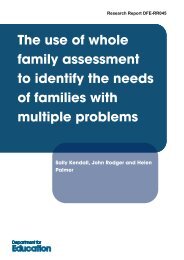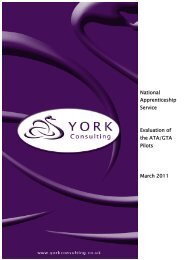Recruitment and Retention in the Post-16 Learning and Skills Sector
Recruitment and Retention in the Post-16 Learning and Skills Sector
Recruitment and Retention in the Post-16 Learning and Skills Sector
Create successful ePaper yourself
Turn your PDF publications into a flip-book with our unique Google optimized e-Paper software.
3 MOTIVATION TO JOIN THE SECTOR3.1 There are a range of reasons why people choose to jo<strong>in</strong> <strong>the</strong> post-<strong>16</strong>learn<strong>in</strong>g <strong>and</strong> skills sector. This section covers issues relat<strong>in</strong>g to <strong>the</strong>background <strong>and</strong> characteristics of those jo<strong>in</strong><strong>in</strong>g <strong>and</strong> <strong>the</strong>ir specificmotivations to jo<strong>in</strong> <strong>the</strong> sector.Background <strong>and</strong> Characteristics of Those Jo<strong>in</strong><strong>in</strong>g3.2 There is a wide range of variation across <strong>the</strong> sector <strong>in</strong> terms of <strong>the</strong> po<strong>in</strong>tat which teachers/tra<strong>in</strong>ers jo<strong>in</strong> <strong>the</strong> post-<strong>16</strong> workforce. Key attributesexplored below <strong>in</strong>clude:• start<strong>in</strong>g age;• prior occupation.Start<strong>in</strong>g Age3.3 Three-fifths of respondents (61%) started work<strong>in</strong>g <strong>in</strong> <strong>the</strong> learn<strong>in</strong>g <strong>and</strong>skills sector between <strong>the</strong> ages of 18 <strong>and</strong> 34. A fur<strong>the</strong>r 28% ofrespondents started between <strong>the</strong> ages of 35 <strong>and</strong> 44.3.4 Those work<strong>in</strong>g only <strong>in</strong> fur<strong>the</strong>r education were more likely to start work<strong>in</strong>g<strong>in</strong> <strong>the</strong> sector aged 18 to 34 (68%). Those work<strong>in</strong>g only <strong>in</strong> adult <strong>and</strong>community learn<strong>in</strong>g are less likely (51%) , but have a higher propensityto start work<strong>in</strong>g aged 35-44 (33%) <strong>and</strong> 45-54 (12%) compared withfur<strong>the</strong>r education (24% <strong>and</strong> 6% respectively). The sector start<strong>in</strong>g agesof those work<strong>in</strong>g <strong>in</strong> work based learn<strong>in</strong>g are between <strong>the</strong>se twoextremes.Prior Occupation3.5 The majority of staff (78%) work<strong>in</strong>g <strong>in</strong> post-<strong>16</strong> learn<strong>in</strong>g <strong>and</strong> skillsoccupations ga<strong>in</strong>ed experience <strong>in</strong> o<strong>the</strong>r <strong>in</strong>dustry sectors. Smallerproportions came from different routes as outl<strong>in</strong>ed below:• 12% of respondents had no previous occupational experience <strong>and</strong>came directly <strong>in</strong>to <strong>the</strong> sector after full-time education;• 9% of respondents worked as a school teacher before jo<strong>in</strong><strong>in</strong>g <strong>the</strong>sector;• 1% of respondents had previously worked as a university lecturer.24











